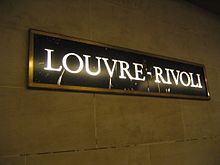Louvre - Rivoli (Paris Métro)
|
|
|
|---|---|

|
|
| Tariff zone | 1 |
| Line (s) |
|
| place | Paris I |
| opening | August 13, 1900 |

Louvre - Rivoli is an underground station on Line 1 of the Paris Métro .
location
The metro station is located in the 1st arrondissement of Paris at the intersection of district Quartier du Palais Royal, St Germain l'Auxerrois and Quartier des Halles. It is located lengthways below the Rue de Rivoli at its intersection with the Rue de l'Amiral-de-Coligny.
Surname
It is named after the Louvre Palace , one of the Parisian residences of the French kings. It lost this function in 1678, and since 1791 it has housed the Musée du Louvre , today the most visited art museum in the world.
In 1989 the metro station was given the addition of "Rivoli", as the new main entrance to the museum is closer to the Palais Royal - Musée du Louvre station, which has also been renamed . The Rue Rivoli takes its name from the Italian city of Rivoli , where Napoleon Bonaparte defeated a numerically superior Habsburg army in the Italian campaign in 1797 .
history
The station was opened on August 20, 1900, one month after the commissioning of line 1, under the name "Louvre" as one of the first Parisian underground stations. It was built using the cut-and- cover method and was initially 75 m long. At the beginning of the 1960s, it was extended to 90 m and converted for use with rubber-tyred trains .
In September 1968, work began on preparing the station near the museum accordingly. The walls were clad with natural stone from Burgundy and the supporting columns were encased in a Doric style . In cabinets and niches were replicas displayed in the museum exhibited art works. After 1989, the décor could give those unfamiliar with the area the impression that it was still the station closest to the museum entrance, which has not been the case since then. It was therefore removed in 2011.
The platforms were raised in February 2009, as part of the introduction of driverless operation on Line 1, and provided with platform screen doors.
description
In contrast to the elliptical cross-section, which is more common in Paris , the station has a horizontal metal ceiling. Longitudinal girders, which carry small vaults made of bricks, rest on iron support beams that are perpendicular to the direction of travel. The extension from the 1960s lies under a round vault that rests on pillars near the platform edge.
Métrolinie 7 crosses below the station , but there was no station there. Interchange stations between the two lines are the neighboring Palais Royal - Musée du Louvre and Châtelet metro stations .
The station has two side platforms on two main tracks. The only access is on Rue de l'Amiral-de-Coligny, it has the Art Nouveau décor designed by Hector Guimard .
vehicles
Initially, trains ran on Line 1, which consisted of a railcar with only one driver's cab and two sidecars . These vehicles were two-axle and each nearly nine meters long. As early as 1902, eight-car trains were formed, each with a railcar at the ends of the train. The railcars were replaced by four-axle vehicles on bogies until 1905, and the sidecars from 1906 . In 1908, green painted five-car trains of the Sprague-Thomson design entered Line 1, which stayed there until the 1960s. From May 1963, the Sprague-Thomson trains, which ran on rails, were successively replaced by the MP 59 series with rubber-tyred vehicles , until December 1964 there was mixed traffic of the two modes of operation. The MP 89 CC series followed in 1997, which gave way to the MP 05 series with the start of automatic operation .
Surroundings
- Late Gothic parish church of Saint-Germain-l'Auxerrois , five-aisled basilica built from 1425
- Pont des Arts , a pedestrian bridge over the Seine
Remarks
- ^ After the metro accident at Couronnes station in August 1903, both railcars ran one behind the other at the Zugspitze
- ↑ In contrast to the other lines, the trains on line 1 were light gray from the early 1930s (with the first class car that was still red)
- ↑ CC means "Conduite Conducteur" (driver-controlled), in contrast to the driverless type MP 89 CA
Web links
literature
- Gérard Roland: Stations de métro. D'Abbesses à Wagram . Bonneton, Paris 2003, ISBN 2-86253-307-6 .
Individual evidence
- ^ A b Gérard Roland: Stations de métro d'Abbesses à Wagram . Christine Bonneton, Clermont-Ferrand 2011, ISBN 978-2-86253-382-7 , pp. 135 .
- ^ Jean Tricoire: Un siècle de métro en 14 lignes. De Bienvenüe à Météor . 2nd Edition. La Vie du Rail, Paris 2000, ISBN 2-902808-87-9 , p. 130 f .
- ^ Brian Hardy: Paris Metro Handbook . 3. Edition. Capital Transport Publishing, Harrow Weald 1999, ISBN 1-85414-212-7 , pp. 36 .
- ↑ Jean Tricoire: op. Cit. P. 134.
- ↑ Jean Tricoire: op. Cit. P. 132 ff.
| Previous station | Paris metro | Next station |
|---|---|---|
|
Palais Royal - Musée du Louvre ← La Défense |
|
Châtelet Château de Vincennes → |
Coordinates: 48 ° 51 ′ 39.3 " N , 2 ° 20 ′ 27" E

